European Extremely Large Telescope
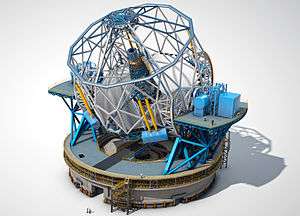 Engineer rendering of the 39-metre European Extremely Large Telescope (E-ELT) | |
| Organisation | ESO |
|---|---|
| Location(s) | Cerro Armazones, Chile, near Paranal Observatory |
| Coordinates | 24°35′20″S 70°11′32″W / 24.58889°S 70.19222°WCoordinates: 24°35′20″S 70°11′32″W / 24.58889°S 70.19222°W |
| Altitude | 3,060 m (10,040 ft)[1] |
| Weather |
89% clear fraction [2] 0.67″ median seeing at 500 nm [3] |
| Wavelength | visible, near and mid-infrared |
| Built |
start: July 2014 (construction) [4] first light: by 2024 (expected) [5] |
| First light | 2024 |
| Telescope style | Reflector |
| Diameter | 39.3 m (129 ft) |
| Secondary dia. | 4.09 m [6]:124 |
| Tertiary dia. | 3.75 m [6]:134 |
| Angular resolution | 0.001 to 0.65 arcsec depending on instrument |
| Collecting area | 978 m2 |
| Focal length |
34.5 m (f/0.88) primary [6]:94 420–840 m (f/10 – f/20) final |
| Mounting | Nasmyth mount |
| Enclosure | classical [7] |
| Website |
eso |
The European Extremely Large Telescope (E-ELT) is an astronomical observatory and the world's largest optical/near-infrared extremely large telescope now under construction. Part of the European Southern Observatory (ESO), it is located on top of Cerro Armazones in the Atacama Desert of northern Chile. The design comprises a reflecting telescope with a 39.3-metre-diameter segmented primary mirror and a 4.2-metre-diameter secondary mirror, and will be supported by adaptive optics, six laser guide star units and multiple large science instruments.[8] The observatory aims to gather 13 times more light than the largest optical telescopes existing today, be able to correct for atmospheric distortions and provide images 16 times sharper than those from the Hubble Space Telescope.[9]
The E-ELT is intended to vastly advance astrophysical knowledge by enabling detailed studies of planets around other stars, the first galaxies in the Universe, super-massive black holes, and the nature of the Universe's dark sector, and to detect water and organic molecules in protoplanetary disks around other stars.[10] The facility is expected to take 11 years to construct.[11]
On 11 June 2012, the ESO Council approved the E-ELT programme's plans to begin civil works at the telescope site, with construction of the telescope itself pending final agreement with governments of some member states.[12] Construction work on the E-ELT site started in June 2014.[4] In December 2014 ESO had secured over 90% of the total funding and authorized construction of the telescope to start, which will cost around one billion Euro for the first construction phase.[13] First light is planned for 2024.[5]
History
On 26 April 2010, the European Southern Observatory (ESO) Council selected Cerro Armazones, Chile, as the baseline site for the planned E-ELT.[14] Other sites that were under discussion included Cerro Macon, Salta, in Argentina; Roque de los Muchachos Observatory, on the Canary Islands; and sites in South Africa, Morocco, and Antarctica.[15][16]
Early designs included a segmented primary mirror with a diameter of 42 metres and area of about 1,300 m2, with a secondary mirror with a diameter of 5.9 m. However, in 2011 a proposal was put forward to reduce its size by 13% to 978 m2, for a 39.3 m diameter primary mirror and a 4.2 m diameter secondary mirror.[8] It reduced projected costs from 1.275 billion to 1.055 billion euros and should allow the telescope to be finished sooner. The smaller secondary is a particularly important change; 4.2 m places it within the capabilities of multiple manufacturers, and the lighter mirror unit avoids the need for high-strength materials in the secondary mirror support spider.[6]:15
ESO's Director General commented in a 2011 press release that "With the new E-ELT design we can still satisfy the bold science goals and also ensure that the construction can be completed in only 10–11 years."[18] The ESO Council endorsed the revised baseline design in June 2011 and expected a construction proposal for approval in December 2011.[18] Funding was subsequently included in the 2012 budget for initial work to begin in early 2012.[19] The project received preliminary approval in June 2012.[12] ESO approved the start of construction in December 2014, with over 90% funding secured.[13]
The design phase of the 5-mirror anastigmat was fully funded within the ESO budget. With the recent changes in the baseline design (such as a reduction in the size of the primary mirror from 42 m to 39.3 m), the construction cost is estimated to be €1.055 billion (including first generation instruments).[20] The start of operations is planned for 2024.[5]
Planning

The ESO focused on the current design after a feasibility study concluded the proposed 100 metres (330 ft) diameter Overwhelmingly Large Telescope would cost €1.5 billion (£1 billion), and be too complex. Current fabrication technology limits single mirrors to being roughly 8 metres (26 ft) in a single piece. The next-largest telescopes currently in use are the Keck Telescopes, the Gran Telescopio Canarias and the Southern African Large Telescope, which each use hexagonal mirrors fitted together to make a mirror more than 10 metres (33 ft) across. The E-ELT will use a similar design, as well as techniques to work around atmospheric distortion of incoming light, known as adaptive optics.[21]
A 40-metre-class mirror will allow the study of the atmospheres of extrasolar planets.[22] The E-ELT is the highest priority in the European planning activities for research infrastructures, such as the Astronet Science Vision and Infrastructure Roadmap and the ESFRI Roadmap.[23] The telescope underwent a Phase B study in the past couple of years that included "contracts with industry to design and manufacture prototypes of key elements like the primary mirror segments, the adaptive fourth mirror or the mechanical structure (...) [and] concept studies for eight instruments.”[24]
Design
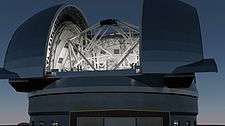

The telescope's segmented mirror will be 39.3 metres in diameter and will gather 15 times more light than the largest optical telescopes operating at the time of its development. The telescope has an innovative five-mirror design that includes advanced adaptive optics to correct for the turbulent atmosphere, giving exceptional image quality.[21]
The primary mirror for the 39.3-metre design will be composed of 798 hexagonal segments, each 1.45 metres across and 50 mm thick. A special correcting mirror in the telescope will be supported by more than 6,000 actuators that can distort its shape a thousand times per second.[25] The telescope main structure will weigh about 2,800 tonnes.[26] The Italian ACe Consortium will manufacture, transport, and assemble the E-ELT's frame and protective dome.[27]

- Dome structure: The E-ELT dome has a height of around 79 meters from the ground and 86 meters of diameter, making it the largest dome built for a telescope. For the observing slit, two main designs were under study: one with two sets of nested doors, and the current baseline design, i.e. a single pair of large sliding doors. This pair of doors has a total width of 45.3 m. Its construction together with the main structure of the telescopes was awarded by the European Southern Observatory to contractors Astaldi and Cimolai and subcontractor EIE. The signature ceremony took place on 25 May 2016 [28] at ESO’s Headquarters in Garching near Munich, Germany. The dome is required to provide protection to the telescope in inclement weather and during the day. A number of concepts for the dome were evaluated. The baseline concept for the 40m-class E-ELT dome is a nearly hemispherical dome, rotating atop a concrete pier, with curved laterally opening doors. This is a re-optimisation from the previous design, aimed at reducing the costs, and it is being revalidated to be ready for construction.[29][30][31]
- Astronomical performance: In terms of astronomical performance the dome is required to be able to track about the 1-degree zenithal avoidance locus and preset to a new target within the allocated 5 minutes for the preset. This requires the dome to be able to accelerate and move at angular speed of 2 degrees/s (the linear speed is approximately 5 km/h). The dome is designed to allow complete freedom to the telescope to position itself whether it be opened or closed and to permit observations from zenith down to 20 degrees from the horizon.
- Windscreen: With such a large opening, the E-ELT dome requires the presence of a windscreen to protect the telescope primary and other mirrors, other than the secondary, from direct exposure to the wind. The baseline design of the windscreen minimises the volume required to house it. Two spherical blades, either side of the observing slit doors, slide in front of the telescope aperture to restrict the wind.
- Ventilation and air-conditioning: The dome design ensures that the dome provides sufficient ventilation for the telescope not to be limited by dome seeing. For this the dome is also equipped with louvers and the windscreen is designed to allow the louvers of the main dome to fulfill their function. Computational fluid dynamic simulations and wind tunnel work are carried out to study the airflow in and around the dome and the effectiveness of the dome and windscreen in protecting the telescope. Beside being designed for water-tightness, air tightness is also one of the requirements as it is critical to minimise the air-conditioning load. The air-conditioning of the dome is necessary not only to thermally prepare the telescope for the forthcoming night but also in order to keep the telescope optics clean. The air-conditioning of the telescope during the day has been considered critical and the current specifications permit the dome to cool the telescope and dome internal volume by 10 °C during 12 hours.
Science goals
The E-ELT will search for extrasolar planets — planets orbiting other stars. This will include not only the discovery of planets down to Earth-like masses through indirect measurements of the wobbling motion of stars perturbed by the planets that orbit them, but also the direct imaging of larger planets and possibly even the characterisation of their atmospheres.[32] The telescope will attempt to image Earthlike exoplanets, which may be possible.[8]
Furthermore, the E-ELT's suite of instruments will allow astronomers to probe the earliest stages of the formation of planetary systems and to detect water and organic molecules in protoplanetary discs around stars in the making. Thus, the E-ELT will answer fundamental questions regarding planet formation and evolution.[10]

By probing the most distant objects the E-ELT will provide clues to understanding the formation of the first objects that formed: primordial stars, primordial galaxies and black holes and their relationships. Studies of extreme objects like black holes will benefit from the power of the E-ELT to gain more insight into time-dependent phenomena linked with the various processes at play around compact objects.[32]
The E-ELT is designed to make detailed studies of the first galaxies and to follow their evolution through cosmic time. Observations of these early galaxies with the E-ELT will give clues that will help understand how these objects form and evolve. In addition, the E-ELT will be a unique tool for making an inventory of the changing content of the various elements in the Universe with time, and to understand star formation history in galaxies.[33]
One of the goals of the E-ELT is the possibility of making a direct measurement of the acceleration of the Universe's expansion. Such a measurement would have a major impact on our understanding of the Universe. The E-ELT will also search for possible variations in the fundamental physical constants with time. An unambiguous detection of such variations would have far-reaching consequences for our comprehension of the general laws of physics.[33]
Instrumentation


The telescope will have several science instruments. It will be possible to switch from one instrument to another within minutes. The telescope and dome will also be able to change positions on the sky and start a new observation in a very short time.
Eight different instrument concepts and two post-focal adaptive modules are currently being studied, with the aim that two to three will be ready for first light, with the others becoming available at various points over the following decade.[35] The instruments being studied are:
- CODEX: a narrow-field, R=135 000 optical spectrograph[36][37]
- EAGLE: a wide-field, multi-channel integral-field near-infrared (NIR) spectrograph, with multi-object adaptive optics[38][39]
- EPICS: a optical/NIR planet imager and spectrograph with extreme adaptive optics[40]
- HARMONI: a single field, wide-band integral field spectrograph[41]
- METIS: a mid-infrared imager and spectrograph[42][43]
- MICADO: a diffraction-limited near-infrared camera[44][45]
- OPTIMOS: a wide-field visual multi-object spectrograph[46]
- SIMPLE: a high-spectral-resolution NIR spectrograph[47][48]
The two post-focal adaptive optics modules currently being studied are:
- ATLAS: a laser tomography adaptive optics module
- MAORY: a multi-conjugate adaptive optics module
Comparison

One of the largest ground-based telescope operating today is the Gran Telescopio Canarias, with a 10.4 m aperture and a light-collecting area of 74 m2. Other planned extremely large telescopes include the 25 m/368 m2 Giant Magellan Telescope and 30 m/655 m2 Thirty Meter Telescope, which are also targeting the beginning of the 2020 decade for completion. These other two telescopes roughly belong to the same next generation of optical ground-based telescopes.[49][50] Each design is much larger than previous telescopes.[8] Even with the descale to 39.3 m the E-ELT is significantly larger than both other planned extremely large telescopes.[8] It has the aim of observing the Universe in greater detail than the Hubble Space Telescope by taking images 15 times sharper, although it is designed to be complementary to space telescopes, which typically have very limited observing time available.[22] The E-ELT's 4.2-meter secondary mirror is the same size as the primary mirror on the William Herschel Telescope, the second largest optical telescope in Europe.
| Name | Aperture diameter (m) | Collecting area (m²) | First light |
|---|---|---|---|
| E-ELT | 39.3 | 978 | 2024 |
| Thirty Meter Telescope (TMT) | 30 | 655 | TBD[51] |
| Giant Magellan Telescope (GMT) | 24.5 | 368 | 2025 |
| Southern African Large Telescope (SALT) | 11.1 × 9.8 | 79 | 2005 |
| Keck Telescopes | 10.0 | 76 | 1990, 1996 |
| Gran Telescopio Canarias (GTC) | 10.4 | 74 | 2007 |
| Very Large Telescope (VLT) | 8.2 | 1998-2000 | |
| Notes: Future first-light dates are provisional and likely to change. | |||
Stills
The images below show artistic renderings of the E-ELT and were produced by ESO.
 Diagram of the 40m-class E-ELT primary mirror.
Diagram of the 40m-class E-ELT primary mirror. E-ELT compared with one of the four existing VLT Unit Telescopes at Cerro Paranal, Chile
E-ELT compared with one of the four existing VLT Unit Telescopes at Cerro Paranal, Chile Rendering of E-ELT during the day.
Rendering of E-ELT during the day. Model of the gigantic and intricate structure inside the enclosure of the E-ELT.
Model of the gigantic and intricate structure inside the enclosure of the E-ELT.
Video
 Artist's impression of the European Extremely Large Telescope (E-ELT) in its enclosure on Cerro Armazones during night-time observations. The four beams shooting skywards are lasers that create artificial stars high in the Earth’s atmosphere.
Artist's impression of the European Extremely Large Telescope (E-ELT) in its enclosure on Cerro Armazones during night-time observations. The four beams shooting skywards are lasers that create artificial stars high in the Earth’s atmosphere..ogv.jpg) This video shows an artist's impression of the European Extremely Large Telescope, the E-ELT. The protective dome is seen opening for a night observing the optical and infrared skies.
This video shows an artist's impression of the European Extremely Large Telescope, the E-ELT. The protective dome is seen opening for a night observing the optical and infrared skies..ogv.jpg)
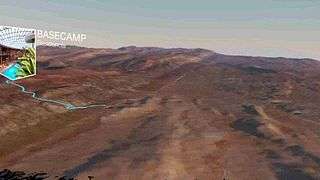 A 3D view of the new road to Cerro Armazones area in the Chilean desert. The road extends from the public Route B-710 to the top of the mountain where the European Extremely Large Telescope (E-ELT) will sit.
A 3D view of the new road to Cerro Armazones area in the Chilean desert. The road extends from the public Route B-710 to the top of the mountain where the European Extremely Large Telescope (E-ELT) will sit. On 19 June 2014, a major milestone towards construction of the E-ELT was reached. Part of Cerro Armazones was blasted. This video provides a closer look at the event. Note that only natural sound is provided.
On 19 June 2014, a major milestone towards construction of the E-ELT was reached. Part of Cerro Armazones was blasted. This video provides a closer look at the event. Note that only natural sound is provided. Numerous construction workers using heavy machinery working in the Atacama Desert to flatten the top of the mountain for a platform large enough to host the E-ELT with its main mirror, 39.2 metres in diameter.
Numerous construction workers using heavy machinery working in the Atacama Desert to flatten the top of the mountain for a platform large enough to host the E-ELT with its main mirror, 39.2 metres in diameter.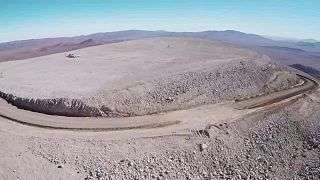 This drone camera view gives an early indication of the scale of the project.
This drone camera view gives an early indication of the scale of the project. A video describing what the E-ELT will be.
A video describing what the E-ELT will be. A camera drone follows sections of the road that connects Cerro Armazones, the site of the E-ELT, to ESO's observatory site at Cerro Paranal, home of the VLT.
A camera drone follows sections of the road that connects Cerro Armazones, the site of the E-ELT, to ESO's observatory site at Cerro Paranal, home of the VLT.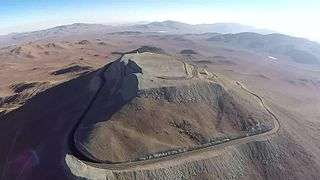 These drone visuals from Gerhard Hüdepohl show the future location of the E-ELT against the tranquil backdrop of the barren Chilean desert, as of September 2016.
These drone visuals from Gerhard Hüdepohl show the future location of the E-ELT against the tranquil backdrop of the barren Chilean desert, as of September 2016.
Comparable instruments
- Giant Magellan Telescope (under construction)
- Overwhelmingly Large Telescope (retired plan)
- Thirty Meter Telescope (planned)
See also
- Cerro Tololo Inter-American Observatory
- European Solar Telescope (planned completion in 2020)
- Gran Telescopio Canarias
- La Silla Observatory
- Large Binocular Telescope
- List of largest optical reflecting telescopes
- List of optical telescopes
- Llano de Chajnantor Observatory
- Paranal Observatory
- Very Large Telescope
References
- ↑ "World's biggest telescope to be located on Cerro Armazones, Chile". Astronomy magazine. 2010-04-28. Retrieved 2011-08-17.
- ↑ Schöck, M.; Els, S.; Riddle, R.; Skidmore, W.; Travouillon, T.; Blum, R.; Bustos, E.; Chanan, G.; Djorgovski, S. G.; Gillett, P.; Gregory, B.; Nelson, J.; Otárola, A.; Seguel, J.; Vasquez, J.; Walker, A.; Walker, D.; Wang, L. (1 April 2009). "Thirty Meter Telescope Site Testing I: Overview". Publications of the Astronomical Society of the Pacific. 121 (878): 384–395. arXiv:0904.1183
 . Bibcode:2009PASP..121..384S. doi:10.1086/599287.
. Bibcode:2009PASP..121..384S. doi:10.1086/599287. - ↑ "E-ELT Site". ESO website. ESO. Retrieved 25 July 2013.
The median seeing is 0.67 arcsec at 500nm with a median coherence time of 3.5 ms.
- 1 2 James Vincent (19 June 2014). "European Extremely Large Telescope to break ground (using dynamite) live later today". The Independent.
- 1 2 3 "Groundbreaking for the E-ELT". ESO. 19 June 2014.
- 1 2 3 4 The E-ELT Construction Proposal (PDF), ESO, 2011-12-02, retrieved 2014-06-22
- ↑ "E-ELT ENCLOSURE". ESO. 21 June 2011.
- 1 2 3 4 5 Govert Schilling (2011-06-14). "Europe Downscales Monster Telescope to Save Money". Science Insider. Retrieved 2011-08-17.
- ↑ ESO. "THE EUROPEAN EXTREMELY LARGE TELESCOPE ("E-ELT") PROJECT".
- 1 2 "ESO - Are We Alone?". Retrieved 2011-06-15.
- ↑ "The E-ELT construction proposal" (PDF). ESO. Retrieved 2011-01-16.
- 1 2 Amos, Jonathan (11 June 2012). "European Extremely Large Telescope given go-ahead". BBC News. Retrieved 11 June 2012.
- 1 2 "Construction of Extremely Large Telescope Approved". Spaceref. 4 December 2014.
- ↑ "E-ELT Site Chosen". ESO. 2010-04-26. Retrieved 2011-08-17.
- ↑ "E-ELT: Finding a home". Retrieved 2011-08-17.
- ↑ Vernin, Jean; Muñoz-Tuñón, Casiana; Sarazin, Marc; Vazquez Ramió, Héctor; Varela, Antonia M.; Trinquet, Hervé; Miguel Delgado, José; Jiménez Fuensalida, Jesús; Reyes, Marcos; Benhida, Abdelmajid; Benkhaldoun, Zouhair; García Lambas, Diego; Hach, Youssef; Lazrek, M.; Lombardi, Gianluca; Navarrete, Julio; Recabarren, Pablo; Renzi, Victor; Sabil, Mohammed; Vrech, Rubén (1 November 2011). "European Extremely Large Telescope Site Characterization I: Overview" (PDF). Publications of the Astronomical Society of the Pacific. 123 (909): 1334–1346. Bibcode:2011PASP..123.1334V. doi:10.1086/662995.
- ↑ "ESO To Build World's Biggest Eye On The Sky". ESO Press Release. Retrieved 13 June 2012.
- 1 2 "ESO Moves One Step Closer to the First Extremely Large Telescope". ESO. 2011-06-15. Retrieved 2011-08-17.
- ↑ "The E-ELT Moves Closer to Reality". ESO. 9 December 2011.
- ↑ "ESO - Preparing a Revolution". Retrieved 2011-06-15.
- 1 2 Gilmozzi, Roberto; Spyromilio, Jason (March 2007). "The European Extremely Large Telescope (E-ELT)" (PDF). The Messenger (127): 11–19. Bibcode:2007Msngr.127...11G.
- 1 2 An Expanded View of the Universe – Science with the European Extremely Large Telescope (PDF). ESO Science Office.
- ↑ "ESO - Europe's Window on the Universe". Retrieved 2011-06-15.
- ↑ Astronet (2008), Michael F. Bode; Maria J. Cruz; Frank J. Molster, eds., The ASTRONET Infrastructure Roadmap: A Strategic Plan for European Astronomy (PDF), p. 43, ISBN 978-3-923524-63-1, retrieved 2014-06-21
- ↑ "E-ELT OPTICS". ESO. 27 June 2011. Retrieved September 2015. Check date values in:
|access-date=(help) - ↑ "E-ELT TELESCOPE DESIGN". ESO. 23 August 2012. Retrieved September 2015. Check date values in:
|access-date=(help) - ↑ Amos, Jonathan (25 May 2016). "E-ELT: Contract to construct giant telescope". BBC News. Retrieved 2016-05-25.
- ↑ "ESO Signs Largest Ever Ground-based Astronomy Contract for E-ELT Dome and Telescope Structure". ESO. 25 May 2016.
- ↑ "E-ELT Phase B Final Design Review" (PDF). ESO Science Office. 25 May 2016.
- ↑ "The UK involvement in the E-ELT".
- ↑ "E-ELT DOME & FOUNDATIONS".
- 1 2 E-ELT The European Extremely Large Telescope — The World's Biggest Eye on the Sky (brochure). ESO.
- 1 2 "ESO - The First Objects in the Universe". Retrieved 2011-08-17.
- ↑ "First Instruments for E-ELT Approved". Retrieved 13 July 2015.
- ↑ "E-ELT Instrumentation". Retrieved 2009-10-29.
- ↑ Pasquini, Luca; et al. (2008). McLean, Ian S; Casali, Mark M, eds. "Proceedings of SPIE—CODEX: the high-resolution visual spectrograph for the E-ELT" (PDF). Ground-based and Airborne Instrumentation for Astronomy II. 7014. SPIE: 70141I–70141I–9. doi:10.1117/12.787936.
- ↑ "CODEX – An ultra-stable, high-resolution optical spectrograph for the E-ELT". IAC. Retrieved 29 November 2012.
- ↑ Cuby, Jean-Gabriel; et al. (2010). McLean, Ian S; Ramsay, Suzanne K; Takami, Hideki, eds. "Proceedings of SPIE—EAGLE: a MOAO fed multi-IFU NIR workhorse for E-ELT" (PDF). Ground-based and Airborne Instrumentation for Astronomy III. 7735. SPIE: 77352D–77352D–15. Bibcode:2010SPIE.7735E..80C. doi:10.1117/12.856820. Retrieved 29 November 2012.
- ↑ "EAGLE: the Extremely Large Telescope Adaptive Optics for Galaxy Evolution instrument". Retrieved 2009-10-29.
- ↑ Kasper, Markus E.; et al. (2008). "EPICS: the exoplanet imager for the E-ELT". Adaptive Optics Systems - Proceedings of the SPIE, Volume 7015. SPIE. pp. 70151S–70151S–12. doi:10.1117/12.789047.
- ↑ Thatte, Niranjan. "HARMONI". University of Oxford. Retrieved 30 November 2012.
- ↑ Brandl, Bernhard. "METIS – The Mid-infrared E-ELT Imager and Spectrograph". METIS consortium. Retrieved 30 November 2012.
- ↑ Brandl, Bernhard R.; et al. (August 2008). McLean, Ian S; Casali, Mark M, eds. "METIS: the mid-infrared E-ELT imager and spectrograph". Proceedings of the SPIE. Ground-based and Airborne Instrumentation for Astronomy II. 7014: 70141N–70141N–15. arXiv:0807.3271
 . Bibcode:2008SPIE.7014E..55B. doi:10.1117/12.789241.
. Bibcode:2008SPIE.7014E..55B. doi:10.1117/12.789241. - ↑ "MICADO – Multi-AO Imaging Camera for Deep Observations". MICADO team. Retrieved 30 November 2012.
- ↑ Davies, Richard; et al. (July 2010). McLean, Ian S; Ramsay, Suzanne K; Takami, Hideki, eds. "MICADO: the E-ELT adaptive optics imaging camera". Proceedings of the SPIE. Ground-based and Airborne Instrumentation for Astronomy III. 7735: 77352A–77352A–12. arXiv:1005.5009
 . Bibcode:2010SPIE.7735E..77D. doi:10.1117/12.856379.
. Bibcode:2010SPIE.7735E..77D. doi:10.1117/12.856379. - ↑ "E-ELT Optical Multi Object Spectrograph". OPTIMOS Consortium. Retrieved 30 November 2012.
- ↑ "SIMPLE - A high resolution near-IR spectrograph for the E-ELT". SIMPLE Consortium. Retrieved 30 November 2012.
- ↑ Oliva, E.; Origlia, L. (August 2008). McLean, Ian S; Casali, Mark M, eds. "High-resolution near-IR spectroscopy: from 4m to 40m class telescopes" (PDF). Proceedings of the SPIE. Ground-based and Airborne Instrumentation for Astronomy II. 7014: 70141O–70141O–7. Bibcode:2008SPIE.7014E..56O. doi:10.1117/12.788821. Retrieved 30 November 2012.
- ↑ "GMT Overview -- Giant Magellan Telescope". Retrieved 2011-06-15.
- ↑ "About TMT -- Thirty Meter Telescope". Retrieved 2011-06-15.
- ↑ Stewart, Burnett, Colin M., John (October 14, 2016). "Hawaii Supreme Court voids Thirty Meter Telescope permit". Oahu Publications. West Hawaii Today. Retrieved 19 December 2015.
External links
| Wikimedia Commons has media related to European Extremely Large Telescope. |
- ESO European Extremely Large Telescope
- ESO The European Extremely Large Telescope ("E-ELT") Project
- Final stage for telescope design
- Green light for ELT
- Ground Telescope to Super Size
- Record mirror for Euro telescope BBC Online August 7 2006
- ESO Council Gives Green Light to Detailed Study of the European Extremely Large Telescope Spaceref.com


